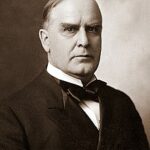The Dingley Tariff Act of 1897 represented President William McKinley’s masterful approach to economic policy. McKinley signed this landmark legislation on July 24, 1897, fulfilling his campaign promise to protect American workers. The act raised average tariff rates to approximately 46.5 percent on dutiable goods.
The Strategic Decision Behind the Dingley Tariff Act
McKinley faced severe economic depression when he took office in March 1897. The Panic of 1893 had devastated American manufacturing and left millions unemployed. The previous Wilson-Gorman Tariff of 1894 had reduced protective duties significantly. McKinley believed strategic protectionism would revive American industry and create jobs. 📊
Key Provisions and Industrial Protection
The Dingley Tariff Act imposed substantial duties on manufactured goods, textiles, and agricultural products. Steel imports faced tariffs exceeding 50 percent in some categories. Wool duties returned to protective levels after being eliminated in 1894. The legislation also included reciprocity provisions allowing presidential trade negotiations. These measures aimed to shield nascent American industries from European competition. 💰
Impact:
The Dingley Tariff Act generated remarkable economic results that validated McKinley’s protectionist strategy. American industrial production surged by over 60 percent between 1897 and 1901. Manufacturing employment increased dramatically as factories expanded operations nationwide. The steel industry experienced unprecedented growth, with production nearly doubling during McKinley’s presidency. 📊
Economic Prosperity and the Dingley Tariff Impact
The legislation contributed to ending the depression that had plagued America since 1893. National income rose substantially as protected industries flourished and expanded. Agricultural machinery manufacturers benefited enormously from reduced foreign competition. The tariff generated significant federal revenue, helping balance the government budget. Workers saw wages increase as labor demand strengthened across multiple sectors. 💰
Long-term Industrial Transformation
McKinley’s tariff policy accelerated America’s emergence as a global industrial powerhouse. The protected domestic market allowed American companies to achieve economies of scale. Steel, textiles, and machinery industries developed technological innovations behind tariff walls. ⚠️ However, some economists argue the policy may have increased consumer prices. The Dingley Tariff remained largely intact until the Payne-Aldrich Tariff of 1909, demonstrating its political durability and perceived success.
